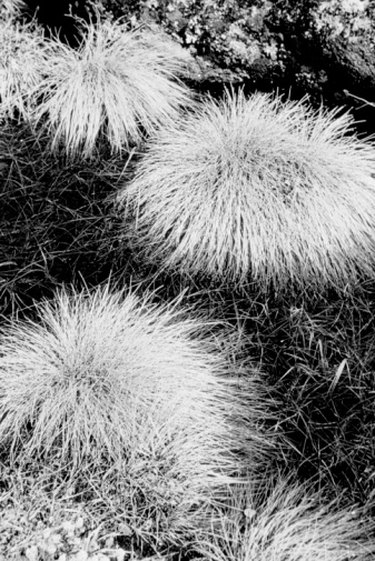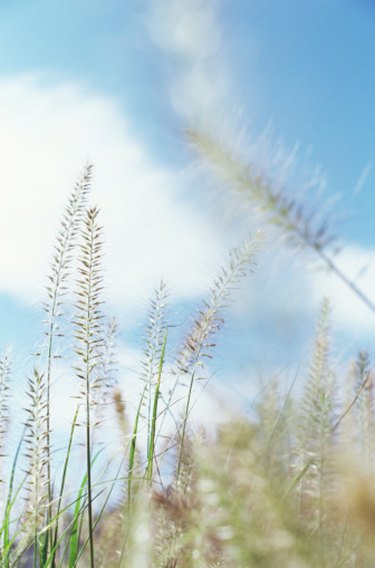
Ornamental grasses typically grow in one of two fashions, either spreading by stolons or rhizomes, like lawn grass, or in restrained clumps. Gardeners needing small, non-invasive grasses should restrict their search to dwarf selections of clumping grasses, such as "Little Bunny" fountain grass, which at 12 inches tall is much smaller than the 3 to 4-foot height of regular fountain grass.
Hair Grass
Video of the Day
Several types of hair grass of the genus Deschampsia thrive in full sun and have restrained growth. The crinkled hair grass, D. flexuosa, forms 1- to 2-foot clumps with twisted flower panicles. The "Gold Dust" cultivar of tufted hair grass, D. caespitosa, grows 1 to 2 feet tall with yellow flowers. Hardiness depends on species but most varieties prefer the cooler temperatures of U.S. Department of Agriculture plant zone 7 and below.
Video of the Day
Blue Fescue
Semi-evergreen blue fescue, Festuca ovina glauca, forms 1-foot clumps of blue-green grass that are topped by seed heads that emerge light green and mature golden-buff. Fescue foliage is very fine and radiates straight out rather than arching downward. "Elijah Blue" is a common cultivar with powdery-blue foliage, while "Boulder Blue" has more intense coloring. Blue fescues grow best in full sun in zones 5 through 8.
Fountain Grass

Fountain grasses (Pennisetum) are named for their cascading, fountain-like habit. Most cultivars of P. orientale grow only 1 to 2 feet high and wide; they bloom early in the summer and are especially drought-tolerant. "Little Bunny" is a 1-foot cultivar of P. alopecuroides, the common perennial fountain grass, and the similarly sized "Little Honey" has variegated foliage. There is also a dwarf selection of the annual red fountain grass, P. setaceum "Rubrum Compactum." Flowering on fountain grass is decreased if not grown in full sun. Most perennial Pennisetums grow in zones 5 through 9, but check plant labels to confirm.
Variegated Oat Grass
Variegated oat grass (Arrhenatherum elatius subsp. bulbosum "Variegatum") is a dwarf cultivar of the larger grass known as bunchgrass. "Variegatum" forms arching, 6- to 12-inch mounds of white-edged, bluish-green leaves. Flowering is insignificant and may be absent entirely in hot climates. Grow variegated oat grass in full sun and well-drained soil; once established, it's drought-tolerant.
Sedges and Dwarf Mondo Grass
Sedges (Carex.) and dwarf mondo grasses (Ophiopogon) are technically not grasses but are often used in gardens as perennial ornamental grasses. Sedges form tufts of long, thin foliage and spread slowly when sited in full sun. Carex morrowii grows 12 inches and is evergreen. The cultivar "Aureovariegata," also sold as "Goldband," has yellow leaf variegation, while "Variegata" has silver stripes. "The Beatles" cultivar of C. speciosa grows just 4 inches tall. Sedge hardiness depends on cultivar, but those mentioned here are all hardy in plant zones 5 through 9. Dwarf mondo grass is also called monkey grass in the South, where it's a common, slow-growing substitute for liriope. "Nana" grows just 4 inches tall, and black mondo grass, O. planiscapus "Ebony Knight," grows 4 to 6 inches tall. Dwarf mondo grasses are hardy in zones 5 to 9.
- University of Vermont; Deschampsia; Dr. Leonard Perry
- Ohio State University: Festuca Ovina Glauca
- University of Vermont; Carex; Dr. Leonard Perry
- Michigan State University Extension: Ophiopogon Japonicus
- University of Vermont; Pennisetum; Dr. Leonard Perry
- University of Vermont; Arrhenatherum Elatius subsp. Bulbosum "Variegatum: Dr. Leonard Perry; November 2005
- Colorado State University Extension; Ornamental Grasses; C. R. Wilson; December 2008
- North Carolina State University; Ornamental Grasses for North Carolina; M. A. Powell; June 1997
- Washington State University Extension; Ornamental Grasses; James W. Gilles, et al.; Aug 2003
- University of Tennessee Extension; Ornamental Grasses in the Landscape; Mary Lewnes Albrecht
- Pennsylvania State University Extension: Ornamental Grasses